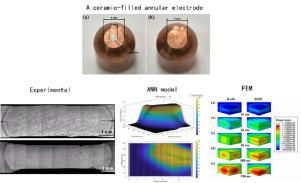当前位置:
X-MOL 学术
›
Int. J. Mech. Sci.
›
论文详情
Our official English website, www.x-mol.net, welcomes your feedback! (Note: you will need to create a separate account there.)
Comparison of mechanical properties and the nugget formation of composite ceramic-centered annular welding and traditional resistance spot welding
International Journal of Mechanical Sciences ( IF 7.3 ) Pub Date : 2020-12-01 , DOI: 10.1016/j.ijmecsci.2020.105933 Dewang Zhao , Daxin Ren , Gang Song , Kunmin Zhao , Liming Liu , Zhaodong Zhang
International Journal of Mechanical Sciences ( IF 7.3 ) Pub Date : 2020-12-01 , DOI: 10.1016/j.ijmecsci.2020.105933 Dewang Zhao , Daxin Ren , Gang Song , Kunmin Zhao , Liming Liu , Zhaodong Zhang

|
Abstract A resistance welding method that uses a composite ceramic-centered annular electrode (RAW) was adopted to improve the weldability of high-strength steel. The design idea was to increase the strength of welded joints by the formation of a large nugget with low indentation depth. The strength and the nugget formation of joints produced by the RAW, and the traditional spot welding (RSW) were comparatively investigated by the microstructural, artificial neural network, and finite element model analyses. The highest failure load reached 22.3 kN in the RAW, and the strongest influence on the strength was welding time, followed by welding current, and electrode force at the end. The interaction between these welding parameters significantly influences the strength of joints in the RAW but not in the RSW. Based on the ANN models, a detailed relationship between the parameters and the strength in RAW were obtained, which also determined that the optimal window of welding parameters in the RAW was larger than that in the RSW. The FEM model analysis showed that the annular nugget was generated first, then expanded outward and inward in RAW, and finally completely fused in the nugget center. The mode of heat transfer and the nugget formation could contribute to better dissipation of the resistance heat generated in the RSW. This “soft” heat distribution yields a large nugget with low indentation depth.
中文翻译:

复合陶瓷圆心环焊与传统电阻点焊力学性能及熔核形成比较
摘要 为了提高高强钢的可焊性,采用复合陶瓷中心环形电极(RAW)的电阻焊方法。设计理念是通过形成具有低压痕深度的大熔核来增加焊接接头的强度。通过显微结构、人工神经网络和有限元模型分析,对 RAW 和传统点焊 (RSW) 产生的接头的强度和熔核形成进行了比较研究。RAW 中最高破坏载荷达到 22.3 kN,对强度影响最大的是焊接时间,其次是焊接电流,最后是电极力。这些焊接参数之间的相互作用会显着影响 RAW 中的接头强度,但不会影响 RSW 中的接头强度。基于人工神经网络模型,获得了RAW中参数与强度之间的详细关系,这也决定了RAW中焊接参数的最佳窗口大于RSW中的焊接参数。有限元模型分析表明,在RAW中首先产生环形熔核,然后向外和向内扩展,最后在熔核中心完全融合。传热模式和熔核形成有助于更好地消散 RSW 中产生的电阻热。这种“软”的热量分布产生了一个具有低压痕深度的大块金。然后在RAW中向外和向内扩展,最后在金块中心完全融合。传热模式和熔核形成有助于更好地消散 RSW 中产生的电阻热。这种“软”的热量分布产生了一个具有低压痕深度的大块金。然后在RAW中向外和向内扩展,最后在金块中心完全融合。传热模式和熔核形成有助于更好地消散 RSW 中产生的电阻热。这种“软”的热量分布产生了一个具有低压痕深度的大块金。
更新日期:2020-12-01
中文翻译:

复合陶瓷圆心环焊与传统电阻点焊力学性能及熔核形成比较
摘要 为了提高高强钢的可焊性,采用复合陶瓷中心环形电极(RAW)的电阻焊方法。设计理念是通过形成具有低压痕深度的大熔核来增加焊接接头的强度。通过显微结构、人工神经网络和有限元模型分析,对 RAW 和传统点焊 (RSW) 产生的接头的强度和熔核形成进行了比较研究。RAW 中最高破坏载荷达到 22.3 kN,对强度影响最大的是焊接时间,其次是焊接电流,最后是电极力。这些焊接参数之间的相互作用会显着影响 RAW 中的接头强度,但不会影响 RSW 中的接头强度。基于人工神经网络模型,获得了RAW中参数与强度之间的详细关系,这也决定了RAW中焊接参数的最佳窗口大于RSW中的焊接参数。有限元模型分析表明,在RAW中首先产生环形熔核,然后向外和向内扩展,最后在熔核中心完全融合。传热模式和熔核形成有助于更好地消散 RSW 中产生的电阻热。这种“软”的热量分布产生了一个具有低压痕深度的大块金。然后在RAW中向外和向内扩展,最后在金块中心完全融合。传热模式和熔核形成有助于更好地消散 RSW 中产生的电阻热。这种“软”的热量分布产生了一个具有低压痕深度的大块金。然后在RAW中向外和向内扩展,最后在金块中心完全融合。传热模式和熔核形成有助于更好地消散 RSW 中产生的电阻热。这种“软”的热量分布产生了一个具有低压痕深度的大块金。


























 京公网安备 11010802027423号
京公网安备 11010802027423号